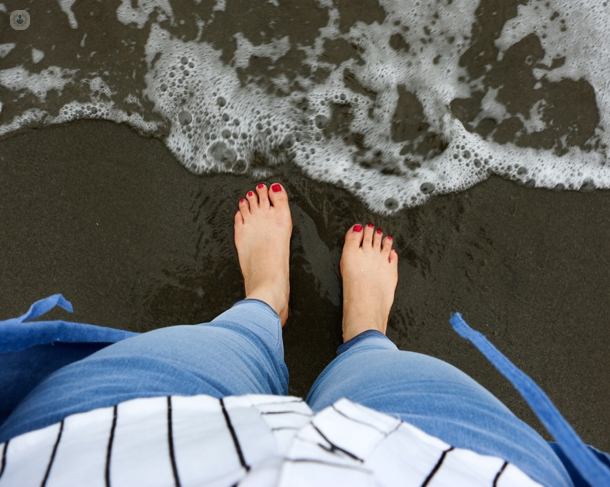Hammer toe: prevention, pain relief and treatment
Written in association with:A hammer toe may be present at birth although its usually developed over time due to arthritis or wearing ill-fitting shoes (for example, pointed heels).

We found out exactly what a hammer toe is by chatting with a renowned orthopaedic surgeon, Mr Rohit Madhav, who gave us information on solutions. He clarified for us some of the available non-surgical and surgical treatment options.
What is a hammer toe?
A hammer toe is part of a spectrum of lesser toe deformities that can occur. These include:
Mallet toe - when a toe is bent right at the tip.
Claw toe - This is when a toe is raised in the toe crease area (otherwise known as the MTP joint) and is misshaped.
Between these two types lies the hammer toe or elevated hammer toe this is where the toe joint is bent in the middle in an upside-down V position. The hammer toe can occur in isolation or associated with other toes, mainly 2nd, 3rd and 4th.
Approximately 3 million people in the UK will have hammer toes and they are often hereditary, as a result of naturally long 2nd and 3rd toes. They are most commonly associated with a hallux valgus or bunion.
What causes a hammer toe?
Hammer toes usually appear as a result of a muscle imbalance, this is usually in combination with shoes that do not fit properly and other factors such as joint inflammation, neurological problems or tendon injury.
Muscles across joints tend to work in synchrony to bend and straighten the toes. If they become imbalanced and the toe is held in a position for long enough, the muscles can tighten further as do the joint structures themselves, and therefore can no longer stretch out. If the shoes do not fit well, they can also push the toes into a bent or flexed position.
Often as they become fixed or stiff they start to rub against the shoes, which then leads to formation of calluses or corns which are thickening nodules on the skin that further aggravate the condition.
What are symptoms of the hammer toe?
Hammer toes can cause pain, predominantly due to rubbing against shoes. The calluses and cons that form from the rubbing can become very painful. It can cause inflammation or underlying bursitis, a sac of fluid forming, this can cause sudden severe pain, and occasionally it can become infected.
How is a hammer toe treated?
Hammer toes can be subdivided into two distinct types:
‘Flexible’ - This would be easily correct with manipulation.
‘Fixed’ - where the joints are no longer flexible and the deformity is static.
Non-surgical treatment options can reduce symptoms. These include shoes with roomy soft uppers and toe boxes. This can be used in combination with non-medicated corn pads or various strapping cushions. You can also prescribe some toe exercises to do at home to stretch and strengthen and rebalance the muscles and joints.
Hammer toes can be corrected surgically, this is usually required due to the progressive nature of the problem, and is often done as an outpatient or day care basis under regional anaesthesia. The type of procedure will depend on the extent and nature of the deformity.
Following surgery there is often some swelling and stiffness with redness and the toe will be a different size, but done appropriately should be in proportion with other toes and will be in line with them.
Post-surgery, you will be able to walk but will be limited in the first instance whilst the bone and tissues heal. During this period, the foot may need to keep the foot elevated as much as possible.
The surgery comprises of flexible correction in terms of releasing the tightness in the soft tissues and tendons to rebalance the joints. It also and moves stiffening the joints straight. Although patients are still able to grip the floor and maintain balance and posture.
Are there any new treatments or procedures for treating hammer toe?
Traditionally hammer toe surgery would require the use of a wire protruding from the tip of the toe and would be up to 10mm long. It was at risk of getting bumped and becoming infected. For many, it was definitely a source of inflammation and pain. This was usually kept in for up to six weeks which made wearing shoes a challenge and walking was more difficult as well.
The surgery is performed nowadays has led to improvements. The soft tissue corrections which require release of tightly contracted tissues and tendons can be done percutaneously or with minimally invasive (keyhole) surgery. Through minimally invasive osteotomies, some bony correction can also be achieved.
The full correction and straightening of a joint can now be undertaken using a sideways cut along the knuckle joint, this hides the scar in the crease. The stiff and damaged joint end can be removed and a small internal plastic pin can be placed to connect the two bones together, thus straightening the toe.
The operation takes roughly 20 minutes. Advantages of this surgical method are that the scar is well tolerated and hidden in the skin crease. As soon as the wound heals after 12 days, you can wear shoes. The internal pin maintains the new position of the toe whilst the bone and tissues continue to heal. This method allows patients to return to various aspects of their life gradually and much quicker than if they had been operated on using the traditional techniques.
If you feel you will require surgery for a hammer toe or correction of deformities of bones or muscles, you may wish to book an e-Consultation or appointment with a leading orthopaedic surgeon such as Mr Rohit Madhav . Visit his profile today for more information.


